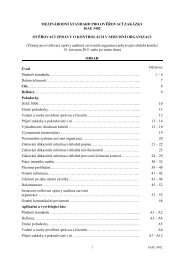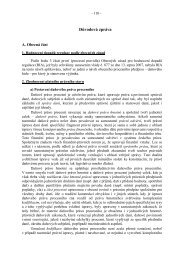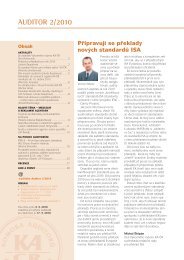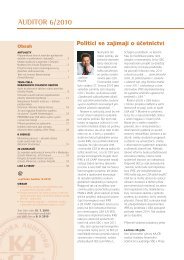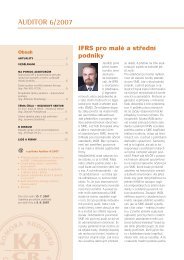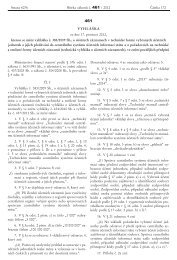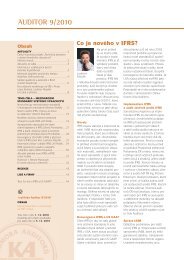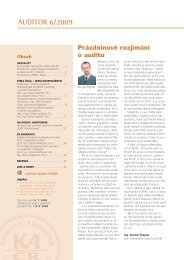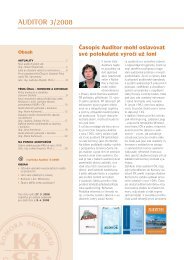Guide to Using International Standards on Auditing in - IFAC
Guide to Using International Standards on Auditing in - IFAC
Guide to Using International Standards on Auditing in - IFAC
You also want an ePaper? Increase the reach of your titles
YUMPU automatically turns print PDFs into web optimized ePapers that Google loves.
137<br />
<str<strong>on</strong>g>Guide</str<strong>on</strong>g> <str<strong>on</strong>g>to</str<strong>on</strong>g> <str<strong>on</strong>g>Us<strong>in</strong>g</str<strong>on</strong>g> <str<strong>on</strong>g>Internati<strong>on</strong>al</str<strong>on</strong>g> <str<strong>on</strong>g>Standards</str<strong>on</strong>g> <strong>on</strong> <strong>Audit<strong>in</strong>g</strong> <strong>in</strong> the Audits of Small- and Medium-Sized Entities Volume 1—Core C<strong>on</strong>cepts<br />
Paragraph #<br />
Relevant Extracts from ISAs<br />
540.7 For purposes of the ISAs, the follow<strong>in</strong>g terms have the mean<strong>in</strong>gs attributed below:<br />
(a) Account<strong>in</strong>g estimate—An approximati<strong>on</strong> of a m<strong>on</strong>etary amount <strong>in</strong> the absence of a<br />
precise means of measurement. This term is used for an amount measured at fair value<br />
where there is estimati<strong>on</strong> uncerta<strong>in</strong>ty, as well as for other amounts that require estimati<strong>on</strong>.<br />
Where this ISA addresses <strong>on</strong>ly account<strong>in</strong>g estimates <strong>in</strong>volv<strong>in</strong>g measurement at fair value,<br />
the term “fair value account<strong>in</strong>g estimates” is used.<br />
(b) Audi<str<strong>on</strong>g>to</str<strong>on</strong>g>r’s po<strong>in</strong>t estimate or audi<str<strong>on</strong>g>to</str<strong>on</strong>g>r’s range—The amount, or range of amounts,<br />
respectively, derived from audit evidence for use <strong>in</strong> evaluat<strong>in</strong>g management’s po<strong>in</strong>t<br />
estimate.<br />
(c) Estimati<strong>on</strong> uncerta<strong>in</strong>ty—The susceptibility of an account<strong>in</strong>g estimate and related<br />
disclosures <str<strong>on</strong>g>to</str<strong>on</strong>g> an <strong>in</strong>herent lack of precisi<strong>on</strong> <strong>in</strong> its measurement.<br />
(d) Management bias—A lack of neutrality by management <strong>in</strong> the preparati<strong>on</strong> of <strong>in</strong>formati<strong>on</strong>.<br />
(e) Management’s po<strong>in</strong>t estimate—The amount selected by management for recogniti<strong>on</strong> or<br />
disclosure <strong>in</strong> the f<strong>in</strong>ancial statements as an account<strong>in</strong>g estimate.<br />
(f) Outcome of an account<strong>in</strong>g estimate—The actual m<strong>on</strong>etary amount which results from<br />
the resoluti<strong>on</strong> of the underly<strong>in</strong>g transacti<strong>on</strong>(s), event(s) or c<strong>on</strong>diti<strong>on</strong>(s) addressed by the<br />
account<strong>in</strong>g estimate.<br />
11.1 Overview<br />
When audit<strong>in</strong>g estimates, the objective is <str<strong>on</strong>g>to</str<strong>on</strong>g> obta<strong>in</strong> sufficient appropriate audit evidence about whether:<br />
• Account<strong>in</strong>g estimates, <strong>in</strong>clud<strong>in</strong>g fair value account<strong>in</strong>g estimates <strong>in</strong> the f<strong>in</strong>ancial statements, whether<br />
recognized or disclosed, are reas<strong>on</strong>able; and<br />
• Related disclosures <strong>in</strong> the f<strong>in</strong>ancial statements are adequate <strong>in</strong> the c<strong>on</strong>text of the applicable f<strong>in</strong>ancial<br />
report<strong>in</strong>g framework.<br />
Some f<strong>in</strong>ancial statement items cannot be measured precisely and therefore have <str<strong>on</strong>g>to</str<strong>on</strong>g> be estimated. Such<br />
account<strong>in</strong>g estimates range from the straightforward (such as net realizable values for <strong>in</strong>ven<str<strong>on</strong>g>to</str<strong>on</strong>g>ry and accounts<br />
receivable) <str<strong>on</strong>g>to</str<strong>on</strong>g> the more complex (such as calculat<strong>in</strong>g revenues <str<strong>on</strong>g>to</str<strong>on</strong>g> be recorded from l<strong>on</strong>g-term c<strong>on</strong>tracts and<br />
future liabilities <strong>on</strong> product warranties and guarantees). Estimates can often <strong>in</strong>volve c<strong>on</strong>siderable analyses of<br />
his<str<strong>on</strong>g>to</str<strong>on</strong>g>rical and current data, and the forecast<strong>in</strong>g of future events such as sales transacti<strong>on</strong>s.<br />
The measurement of account<strong>in</strong>g estimates may vary based <strong>on</strong> the requirements of the applicable f<strong>in</strong>ancial<br />
report<strong>in</strong>g framework and the f<strong>in</strong>ancial item <strong>in</strong>volved. For example, the measurement objective of an estimate<br />
may be <str<strong>on</strong>g>to</str<strong>on</strong>g>:<br />
• Forecast the outcome of <strong>on</strong>e or more transacti<strong>on</strong>s, events, or c<strong>on</strong>diti<strong>on</strong>s that gave rise <str<strong>on</strong>g>to</str<strong>on</strong>g> the account<strong>in</strong>g<br />
estimate; or<br />
• Determ<strong>in</strong>e the value of a current transacti<strong>on</strong> or f<strong>in</strong>ancial statement item based <strong>on</strong> c<strong>on</strong>diti<strong>on</strong>s prevalent<br />
at the measurement date, such as estimated market price for a particular type of asset or liability. This<br />
would <strong>in</strong>clude fair value measurements.<br />
The risk of material misstatement aris<strong>in</strong>g from an estimate will often be based <strong>on</strong> the degree of estimati<strong>on</strong><br />
uncerta<strong>in</strong>ty <strong>in</strong>volved. Some of the fac<str<strong>on</strong>g>to</str<strong>on</strong>g>rs <str<strong>on</strong>g>to</str<strong>on</strong>g> c<strong>on</strong>sider are outl<strong>in</strong>ed <strong>in</strong> the follow<strong>in</strong>g exhibit.




